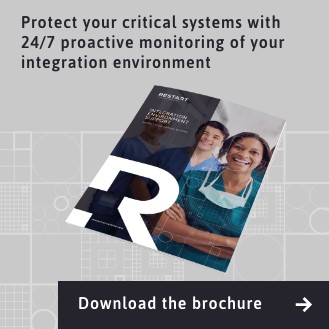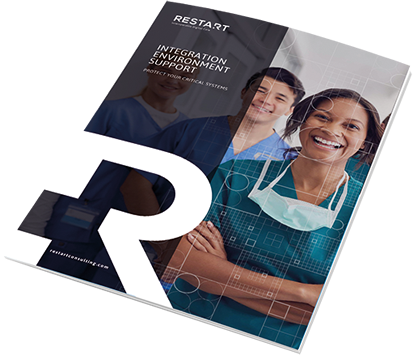Ten signs that you need to upgrade your integration engine
For want of a better phrase, an integration engine is the backbone of your organisation; critical healthcare decisions and patient outcomes rely on the information transferred by it. With the world of health tech and interoperability changing rapidly, particularly during the Covid-19 crisis, how do you ensure your integration engine is fit for purpose today, and in the future?
With over 20 years’ experience deploying, maintaining and monitoring integration engines (including Ensemble/Health Connect, Rhapsody, Mirth, JavaCAPS and Biztalk), our integration experts have put their knowledge into this handy guide explaining the warning signs that your integration engine may need an upgrade.
Download the integration engine support brochure.
Reasons to upgrade your integration engine in health and care

1. Your integration engine is unreliable
Are you suffering from system outages? How quickly are messages getting through? As the lynchpin for your clinical systems, the integration engine enables the smooth flow of real-time information between disparate departments. Without this constant flow, clinicians can be exposed to outdated data causing a risk to patients and delays in the provision of care.
A modern integration engine will have proven performance, as well as the ability to monitor message speeds, delays or failures.
2. End users complain of slow IT systems
Your clinicians may be reporting that their applications are slow to load. Is this consistent feedback or only during periods where there is a surge in demand? This could be due to the capacity of your integration engine to handle message throughput.
In some cases, downstream systems may revert to paper processes to record patient information where an outage or problem occurs. This creates a clinical risk in not being able to access patient records at the point of care as well as possible errors and inconsistencies in recording information manually.
A modern integration engine will almost certainly make a difference to end users and the speed at which data displayed at the point of care.
3. You are unsure if the integration engine is configured for high availability
High availability means that the integration engine has been designed to avoid loss of service by automatically managing failures and downtime. When life or death decisions are potentially at stake, a system is expected to be highly available.
Implementing high availability for your integration engine infrastructure is a critical part of your IT strategy to eliminate single points of failure. High availability can share many of the same characteristics as a backup solution, in terms of a mirror copy of data held on a separate server or in the cloud.
In some situations, your integration engineers will also configure additional screens which mimic your applications (a PAS for example) to enable the uninterrupted care of patients and continuous flow of data across the organisation in the event of unplanned downtime.
Download the integration engine support brochure.
4. It is difficult to add new interfaces to improve interoperability
Your integration engine is only as interoperable as the systems attached to it. With today’s fragmented health tech environment, there is an increasing demand on integration engines to increase capacity as additional systems are brought on stream, or as these systems themselves evolve to deliver better integrated care.
Today’s IT teams need the integration development skills to easily connect not just datasets from internal systems like a new EPR or pathology system but also those of external care settings such as GP information or mental health organisations. You need an integration engine that allows you to connect new applications into infrastructure smoothly and with confidence.
5. Your integration engine doesn’t support APIs or FHIR
Although FHIR (Fast Healthcare Interoperability Resources) is yet to gain significant ground, API’s (Application Programming Interfaces) are fast becoming the go-to method of integrating different systems. This is prevalent in newer technologies such as precision health, self-care applications, virtual appointments and so on.
A modern integration engine must have the ability to integrate APIs and FHIR to transform patient care. Especially since the NHS Long Term Plan is focussed on improving experiences of patients which will be driven by these new health tech innovations.
6. Monitoring of the integration engine is complex
Ideally, your integration engine should enable workflows to be created which alert the right people if a problem occurs. The status of the integration engine plus every interface attached to it should be proactively monitored 24/7 to avoid any potential disruption to patient care.
This integration engine alerting can be customised to notify internal IT staff, management or third-party suppliers depending on the type and severity of the identified issue. You should also be able to define the alert format; whether email, SMS or an alternative channel.
7. Your organisation has recently gone through a merger
Whether it’s individual hospitals, trusts, CCGs, Primary Care Networks (PCN) or Integrated Care Systems (ICS), the NHS is constantly merging organisations in a drive towards greater efficiency and improved patient care.
While merging is never straightforward for any business function, technology is often a particular headache. You will have duplicate patient (or citizen) systems which require consolidation, and there could also be multiple integration engines at play. An audit of existing integration engines should highlight if they’re powerful, scalable and safe enough to provide the strategic capability your new merger demands; or whether investment in a new platform is recommended.
8. You have point to point connections bypassing the integration engine
We find that with some older integration engines, or where there isn’t one, customers have developed a vast array of complex integrations over time. There are often hundreds of interfaces which become impossible to manage and subsequently, impossible to diagnose when issues occur.
The best solution is to consolidate point to point interfaces via one secure, consistent and reliable integration engine, enabling efficient monitoring and accurate troubleshooting. You are also highly likely to come across redundant feeds that can be removed or combined, saving time and cost.
9. The integration engine source code is missing
As with all legacy systems across any industry, it is likely that the source code of your integration engine is either non-existent or poorly maintained. This could also extend to all the interfaces running through the platform. Often the developers who installed the system or developed the interfaces may have long-since left the organisation, making support of the integration engine tricky.
When auditing a legacy system, we commonly find that development standards vary widely. Previous developers often create shortcuts or ‘hacks’ which makes inefficient code that is difficult to read and maintain for future developers.
An experienced healthcare integration expert should be able to reverse engineer the configuration of the platform and of the interfaces, before recommending a new architecture for your upgrade. Read how we helped East Sussex Healthcare NHS Trust do exactly that here.
10. The supplier of your integration engine is not available
Perhaps the biggest indicator that it’s time to upgrade your integration engine is a lack of vendor support. How easy is it to reach an engineer by phone? Is support available 24/7? Are you locked-in with a supplier that doesn’t understand the needs of your organisation and your processes?
The central mission of the integration engine is to maintain healthcare workflows, in real-time, at the point of care. For this reason, you need an integration engine partner you can rely on to proactively help maintain the system; keeping it at the best and most stable that it can be.
The sum of many moving parts
As there are so many moving parts involved, upgrading your integration engine is a huge undertaking for any healthcare organisation. Mapping current and desired architecture, coordinating with downstream third-party suppliers, analysing servers and data repositories, as well as managing internal resources, testing, staff training and engagement.

More information
- Learn more about ReStart’s integration engine services
- Moorfield’s Eye Hospital case study
- Western Sussex Hospitals NHS Foundation Trust case study
Get in touch to discuss your integration engine requirements.

